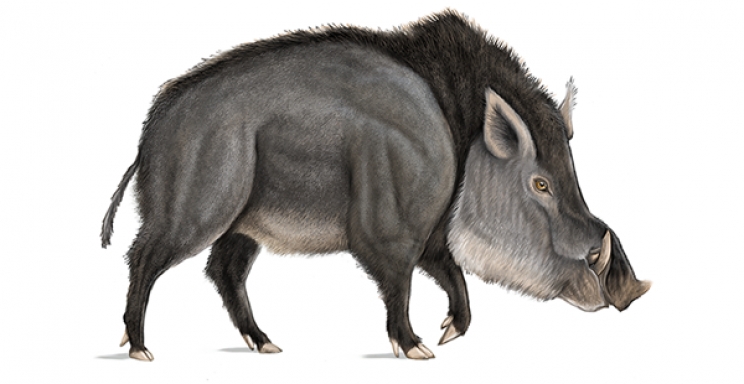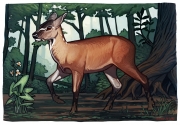Suids are a group of artiodactyl mammals that include modern pigs and wild boars, as well as their extinct relatives. The recently published article in Journal of Mammalian Evolution describes over 100 fossil remains of suids from the Creu de Conill 20 locality, including isolated teeth and maxillary and mandibular fragments, which mostly belong to two species. The most abundant, Propotamochoerus palaeochoerus, belongs to the subfamily of suinae (which includes all modern pigs) and would have been somewhat larger than a modern wild boar; the second most abundant species, Parachleuastochoerus valentini, belongs to the extinct subfamily of tetraconodontines and had a similar size. Some smaller-sized remains could correspond to Albanohyus, the smallest documented suid to date.
Image of maxillary fragments of Propotamochoerus palaeochoerus (top) and Parachleuastochoerus valentini (bottom) in occlusal view. The scale bar is 1 cm. (Modified from McKenzie et al. DOI: 10.1007/s10914-022-09643-3)
In this same locality (Creu de Conill 20) in the Vallès-Penedès basin, the oldest remains of hiparionin horses in Western Europe had previously been found, represented by the genus Hippotherium. This is an extinct group of horses that originated in North America and migrated to the Old World just over 11 million years ago. This dispersal event marks the beginning of the land mammal age known as the Vallesian, which was originally described by the founder of the ICP (Miquel Crusafont-Pairó) in 1950.
The research team responsible for the study consists of Sharrah McKenzie, Leonardo Sorbelli, Àngel H. Luján, Juan Abella, and David M. Alba from the Institut Català de Paleontologia Miquel Crusafont (ICP), and researchers Sergio Almécija (American Museum of Natural History and ICP), Marta Pina (South Bank Applied BioEngineering Research and ICP), Marco Cherin (Università degli Studi di Perugia), and Daniel DeMiguel (ARAID Foundation, University of Zaragoza, and ICP).
Main Image: Reconstruction of the appearance in life of Propotamochoerus palaeochoerus. Roc Olivé / © Institut Català de Paleontologia Miquel Crusafont. With the collaboration of the Fundación Española para la Ciencia y la Tecnología - Ministerio de Economía, Industria y Competitividad.
Original research article:
- McKenzie, S., Sorbelli, L., Cherin, M., Almécija, S., Pina, M., Abella, J., Luján, A., DeMiguel, & D., Alba, D. (2023). Earliest Vallesian suid remains from Creu de Conill 20 (Vallès-Penedès Basin, NE Iberian Peninsula). Journal of Mammalian Evolution. https://doi.org/10.1007/s10914-022-09643-3
















